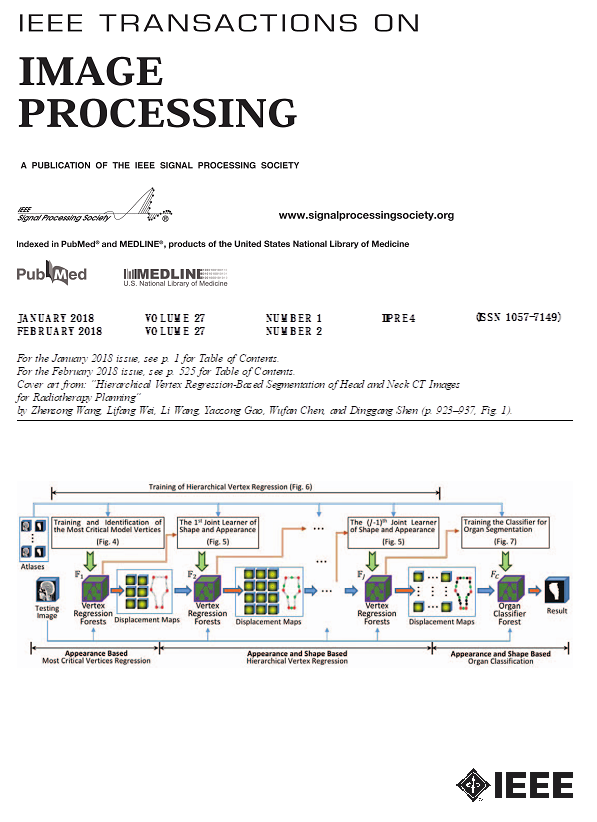端到端单图像雾去除使用增强周期一致对抗网络
IF 10.8
1区 计算机科学
Q1 COMPUTER SCIENCE, ARTIFICIAL INTELLIGENCE
引用次数: 55
摘要
单幅图像去雾是计算机视觉领域的一个经典而又具有挑战性的问题。解决这一问题的现有方法主要包括基于手工先验的方法(依赖于使用大气退化模型)和基于学习的方法(需要成对的无雾训练样例图像)。然而,在实践中,基于先验的方法由于自身的局限性,容易失败,并且配对训练数据的获取极其困难。此外,该领域对非成对可训练除雾网络的研究较少。因此,受CycleGAN网络原理的启发,我们开发了一个端到端的学习系统,该系统使用未配对的雾和无雾训练图像、对抗鉴别器和循环一致性损失来自动构建除雾系统。与CycleGAN类似,我们的系统有两条转换路径;一个将雾图像映射到无雾图像域,另一个将无雾图像映射到雾图像域。我们的系统在每个转换路径中使用两个阶段的映射策略,而不是一个阶段的映射,以提高除雾的有效性。此外,我们通过嵌入大气退化原理和天空先验来将无雾图像映射到雾图像域,从而明确地利用网络中的先验知识。此外,我们还为去雾研究提供了第一个真实世界自然无雾图像数据集。我们的多重真实雾图像数据集(MRFID)包含200个自然户外场景的图像。对于每个场景,都有一个清晰的图像和相应的四个不同雾密度的雾图像,这些雾图像是从固定相机在一年中拍摄的一系列图像中手动选择的。定性和定量比较几种最先进的方法在合成和真实世界的图像表明,我们的方法是有效的,并表现良好,从雾蒙蒙的图像恢复清晰的图像。本文章由计算机程序翻译,如有差异,请以英文原文为准。
End-to-End Single Image Fog Removal Using Enhanced Cycle Consistent Adversarial Networks
Single image defogging is a classical and challenging problem in computer vision. Existing methods towards this problem mainly include handcrafted priors based methods that rely on the use of the atmospheric degradation model and learning-based approaches that require paired fog-fogfree training example images. In practice, however, prior-based methods are prone to failure due to their own limitations and paired training data are extremely difficult to acquire. Moreover, there are few studies on the unpaired trainable defogging network in this field. Thus, inspired by the principle of CycleGAN network, we have developed an end-to-end learning system that uses unpaired fog and fogfree training images, adversarial discriminators and cycle consistency losses to automatically construct a fog removal system. Similar to CycleGAN, our system has two transformation paths; one maps fog images to a fogfree image domain and the other maps fogfree images to a fog image domain. Instead of one stage mapping, our system uses a two stage mapping strategy in each transformation path to enhance the effectiveness of fog removal. Furthermore, we make explicit use of prior knowledge in the networks by embedding the atmospheric degradation principle and a sky prior for mapping fogfree images to the fog images domain. In addition, we also contribute the first real world nature fog-fogfree image dataset for defogging research. Our multiple real fog images dataset (MRFID) contains images of 200 natural outdoor scenes. For each scene, there is one clear image and corresponding four foggy images of different fog densities manually selected from a sequence of images taken by a fixed camera over the course of one year. Qualitative and quantitative comparison against several state-of-the-art methods on both synthetic and real world images demonstrate that our approach is effective and performs favorably for recovering a clear image from a foggy image.
求助全文
通过发布文献求助,成功后即可免费获取论文全文。
去求助
来源期刊

IEEE Transactions on Image Processing
工程技术-工程:电子与电气
CiteScore
20.90
自引率
6.60%
发文量
774
审稿时长
7.6 months
期刊介绍:
The IEEE Transactions on Image Processing delves into groundbreaking theories, algorithms, and structures concerning the generation, acquisition, manipulation, transmission, scrutiny, and presentation of images, video, and multidimensional signals across diverse applications. Topics span mathematical, statistical, and perceptual aspects, encompassing modeling, representation, formation, coding, filtering, enhancement, restoration, rendering, halftoning, search, and analysis of images, video, and multidimensional signals. Pertinent applications range from image and video communications to electronic imaging, biomedical imaging, image and video systems, and remote sensing.
 求助内容:
求助内容: 应助结果提醒方式:
应助结果提醒方式:


